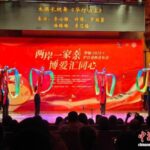This summer, as the excitement of Bilibili World was still lingering, RED LAND by Xiaohongshu quickly followed suit.
From August 8th to 10th, the RED LAND event (Xiaohongshu’s Open World Adventure Island) took place on Fuxing Island. Industrial aesthetics collided with anime culture, transforming Fuxing Island into the world’s first “Itami Island” (a play on “pain” and “island” in Japanese). 70,000 ticket-holding attendees flocked to the venue, packing the 80,000-square-meter space, while nightly music festivals kept the energy high.
The event buzzed with activity, and discussions about it spread far beyond the venue. As another major content platform hosting an anime convention in Shanghai, RED LAND was frequently compared to Bilibili World (Bilibili’s offline carnival).
With these two major events taking turns in the spotlight, Wujiaochang, Shanghai’s anime hub, seemed to become a battleground for an anime-themed “business rivalry.” At Wujiaochang Plaza, the giant Bilibili World posters had yet to be taken down when the adjacent wall was already adorned with RED LAND’s fresh branding.
Head-to-Head Competition?
The unexpected “side-by-side” appearance of RED LAND and Bilibili World drew attention because Xiaohongshu’s first-ever anime convention marked its official entry into the anime content space.
The head of Xiaohongshu’s community marketing for gaming stated: “Investing heavily in this event sends a clear signal to industry players—Xiaohongshu is serious about building anime content. It also shows users what gaming and anime content on our platform looks like.”
Over the past year, anime and gaming-related posts on Xiaohongshu grew by 175% and 168%, respectively, making them the fastest-growing content categories. Anime content has now become the platform’s third-largest vertical, trailing only food and fashion.
Xiaohongshu’s move into anime, a space long dominated by Bilibili, has led some analysts to suggest it could become Bilibili’s biggest competitor in this niche.
Because anime communities are insular with unique cultural codes, user migration is typically difficult, and previous platforms have struggled to challenge Bilibili’s dominance. Xiaohongshu, however, benefits from its algorithmic recommendation system, which allows users to engage independently—a key advantage in building an anime community.
Hosting an anime convention isn’t just a branding exercise; it’s a gathering for anime studios, game companies, and fans. Notably, even the naming convention—RED LAND—mirrors Bilibili World, creating a parallel that makes their “side-by-side” presence in Wujiaochang feel like a showdown between industry giants.
A Shared Celebration
However, this interpretation doesn’t capture the full picture, especially given their different positioning and market dynamics. Rather than a “business rivalry,” the two events are better seen as complementary celebrations in Shanghai.
For one, their focuses differ. Bilibili World emphasizes community culture, creating a fan-centric carnival, while RED LAND prioritizes immersive urban experiences, blending anime into real-world settings.
Xiaohongshu’s anime community lead explained: “RED LAND targets the ‘2.5-dimensional’ crowd, which sets us apart from traditional anime platforms.”
On Xiaohongshu, anime discussions extend beyond game guides and character analysis—users integrate anime into daily life. Some share stunning in-game scenery, while others celebrate fictional characters’ birthdays in real life, breaking the “dimensional wall” to merge anime with offline experiences.
Thus, RED LAND feels less like a conventional convention and more like an anime-themed “Disneyland.” Attendees described it as a “magical day” filled with immersive quests, enthusiastic “island NPCs,” theme-park-like setups, and nightly music parties. Nearly all booths featured interactive activities rather than passive displays.
Moreover, Shanghai’s market is large enough to sustain multiple major anime events.
This year, the city launched its first “Shanghai Summer” International Anime Month, featuring four major events—CCG EXPO, Bilibili World, ChinaJoy, and RED LAND—under the theme “Anime City, Summer High.”
Anime conventions have become some of Shanghai’s hottest offline gatherings. CCG EXPO drew 480 exhibitors globally and debuted a themed boat on





